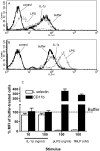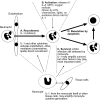The role of interleukin-1beta in direct and toll-like receptor 4-mediated neutrophil activation and survival
- PMID: 15509550
- PMCID: PMC1618681
- DOI: 10.1016/s0002-9440(10)63437-2
The role of interleukin-1beta in direct and toll-like receptor 4-mediated neutrophil activation and survival
Abstract
The regulation of systemic and local neutrophil activation is crucial to the clearance of infections and the successful resolution of inflammation without progress to tissue damage or disseminated inflammatory reactions. Using purified lipopolysaccharide (pLPS) and highly purified neutrophils, we have previously shown that Toll-like receptor 4 signaling is a potent neutrophil activator, but a poor stimulator of survival. In the presence of peripheral blood mononuclear cells (PBMCs), however, pLPS becomes a potent neutrophil survival factor. Interleukin (IL)-1beta has been identified as an important neutrophil activator and prosurvival cytokine, and is produced in abundance by LPS-stimulated PBMCs. We now show that IL-1beta fails to activate highly purified neutrophils or enhance their survival, but in the presence of PBMCs, IL-1beta induces neutrophil survival. We hypothesized that LPS-primed neutrophils might become responsive to IL-1beta, but were unable to demonstrate this. Moreover, IL-1ra failed to prevent pLPS + PBMC-dependent neutrophil survival. In studies of IL-1R1(-/-) mice, we found that LPS was still able to mediate neutrophil survival, and neutrophil survival was enhanced by the addition of monocytic cells. Thus an important paradigm of neutrophil regulation needs to be viewed in the context of a cellular network in which actions of IL-1beta on neutrophils are indirect and mediated by other cells.
Figures







Similar articles
-
Selective roles for Toll-like receptor (TLR)2 and TLR4 in the regulation of neutrophil activation and life span.J Immunol. 2003 May 15;170(10):5268-75. doi: 10.4049/jimmunol.170.10.5268. J Immunol. 2003. PMID: 12734376
-
Relative cytokine and cytokine inhibitor production by mononuclear cells and neutrophils.Shock. 2003 Jul;20(1):10-6. doi: 10.1097/01.shk.0000065704.84144.a4. Shock. 2003. PMID: 12813362
-
Lipopolysaccharide-induced down-regulation of organic anion transporting polypeptide 4 (Oatp4; Slc21a10) is independent of tumor necrosis factor-alpha, Interleukin-1beta, interleukin-6, or inducible nitric oxide synthase.Toxicol Sci. 2005 Jan;83(1):197-203. doi: 10.1093/toxsci/kfi003. Epub 2004 Oct 13. Toxicol Sci. 2005. PMID: 15483191
-
Modulation of Toll-interleukin 1 receptor mediated signaling.J Mol Med (Berl). 2005 Apr;83(4):258-66. doi: 10.1007/s00109-004-0622-4. Epub 2005 Jan 21. J Mol Med (Berl). 2005. PMID: 15662540 Review.
-
Dynamic regulation of the proinflammatory cytokine, interleukin-1beta: molecular biology for non-molecular biologists.Life Sci. 1999;65(5):449-81. doi: 10.1016/s0024-3205(99)00095-8. Life Sci. 1999. PMID: 10462074 Review.
Cited by
-
Eucommiae cortex Comprehensive Phytochemical Analysis Connected with Its In Vitro Anti-Inflammatory Activity in Human Immune Cells.Molecules. 2025 Mar 18;30(6):1364. doi: 10.3390/molecules30061364. Molecules. 2025. PMID: 40142139 Free PMC article.
-
Regulation of neutrophil senescence by microRNAs.PLoS One. 2011 Jan 19;6(1):e15810. doi: 10.1371/journal.pone.0015810. PLoS One. 2011. PMID: 21283524 Free PMC article.
-
Obesity Is Associated with a Weakened Gingival Inflammatory Cytokine Response.Medicina (Kaunas). 2023 Nov 28;59(12):2089. doi: 10.3390/medicina59122089. Medicina (Kaunas). 2023. PMID: 38138192 Free PMC article.
-
Pivotal Advance: Pharmacological manipulation of inflammation resolution during spontaneously resolving tissue neutrophilia in the zebrafish.J Leukoc Biol. 2010 Feb;87(2):203-12. doi: 10.1189/jlb.0409255. J Leukoc Biol. 2010. PMID: 19850882 Free PMC article.
-
Human filarial Wolbachia lipopeptide directly activates human neutrophils in vitro.Parasite Immunol. 2014 Oct;36(10):494-502. doi: 10.1111/pim.12122. Parasite Immunol. 2014. PMID: 24909063 Free PMC article.
References
-
- Ward I, Dransfield I, Chilvers ER, Haslett I, Rossi AG. Pharmacological manipulation of granulocyte apoptosis: potential therapeutic targets. Trends Pharmacol Sci. 1999;20:503–509. - PubMed
-
- Colotta F, Re F, Polentarutti N, Sozzani S, Mantovani A. Modulation of granulocyte survival and programmed cell death by cytokines and bacterial products. Blood. 1992;80:2012–2020. - PubMed
-
- Bossu P, del Grosso E, Cesaroni MP, Maurizi G, Balestro N, Stoppacciaro A, del Giudice E, Ruggiero P, Boraschi D. Balance between autocrine interleukin-1beta and caspases defines life versus death of polymorphonuclear cells. Eur Cytokine Netw. 2001;12:177–186. - PubMed
Publication types
MeSH terms
Substances
LinkOut - more resources
Full Text Sources
Molecular Biology Databases

